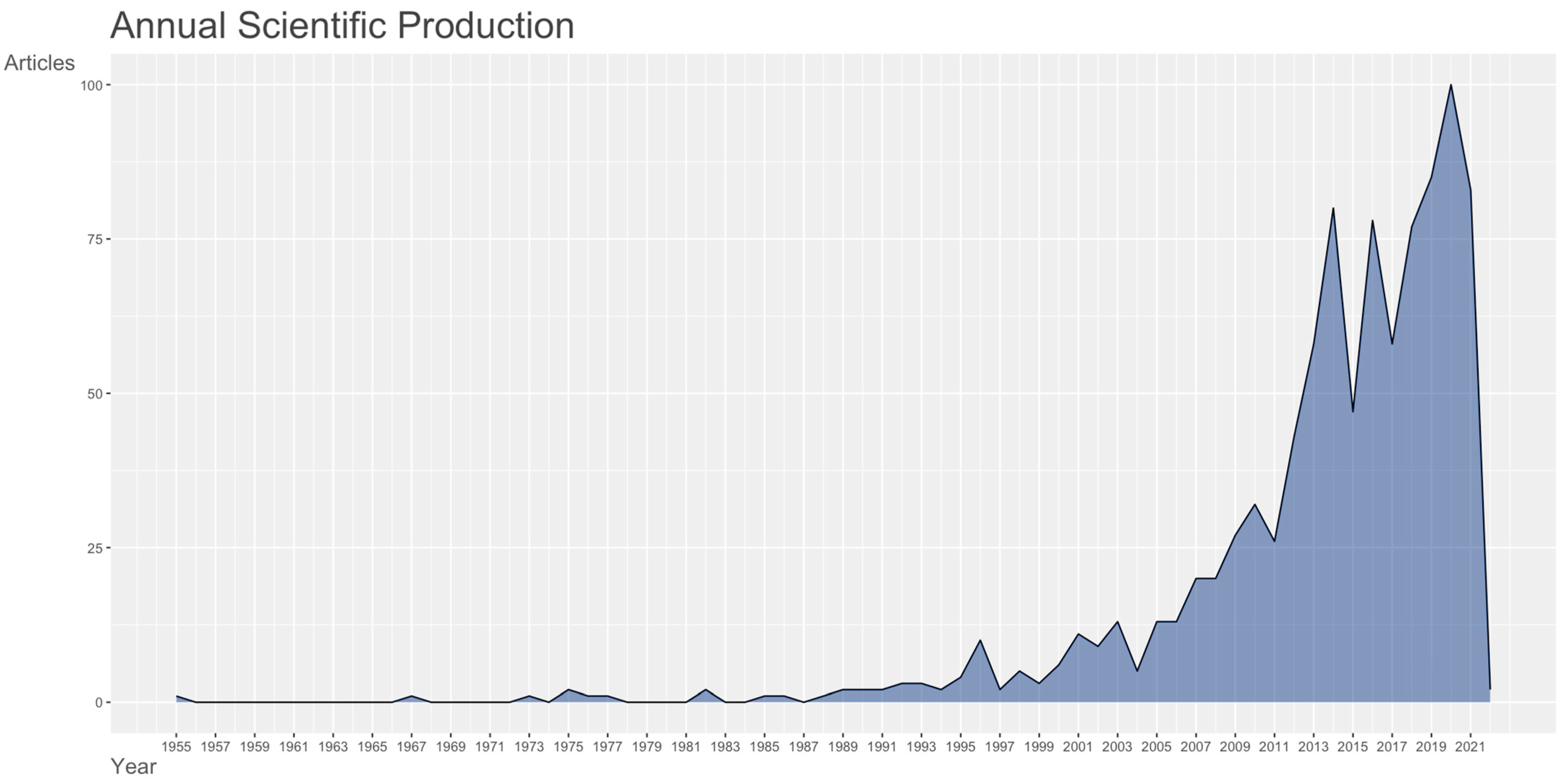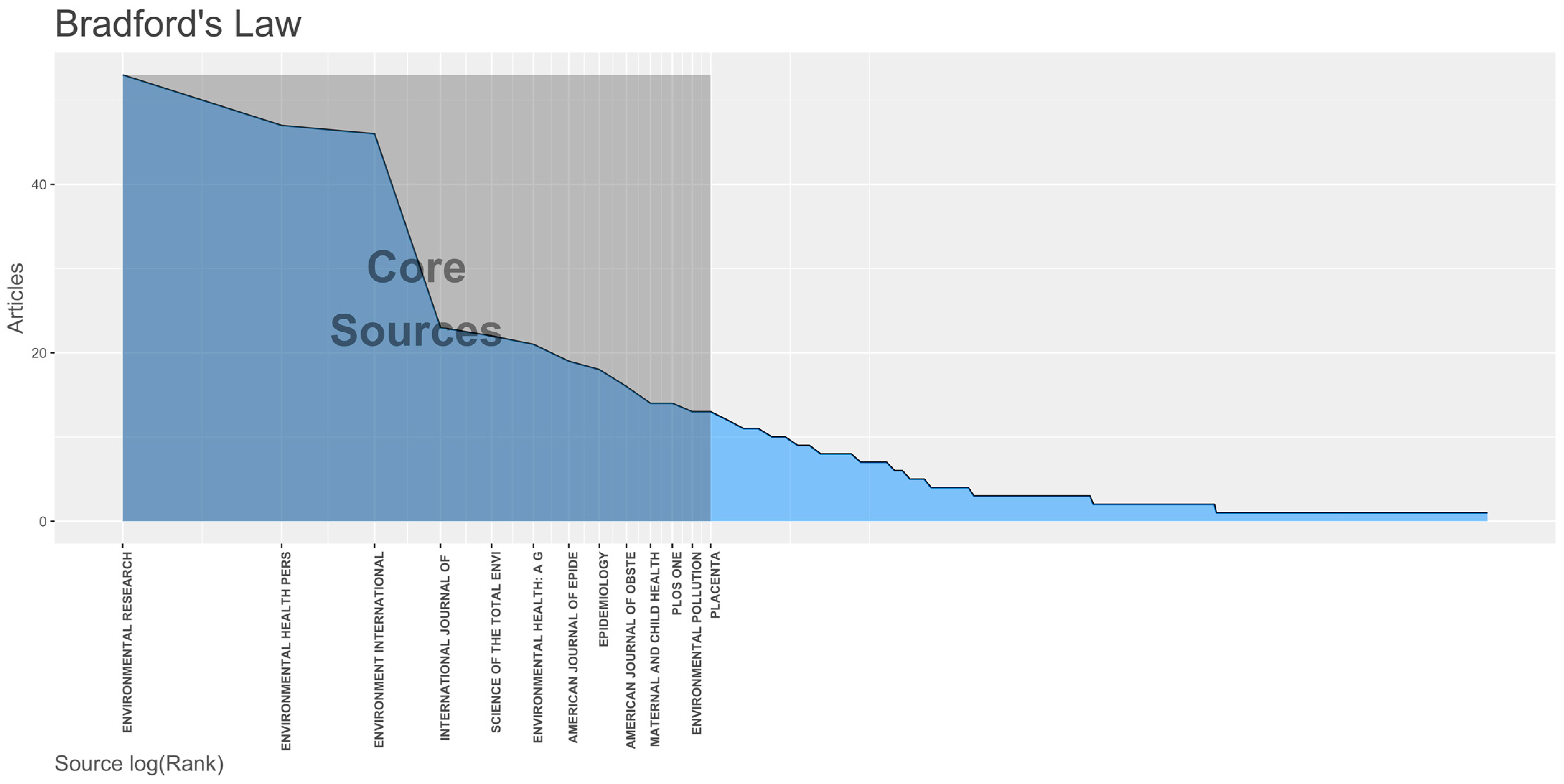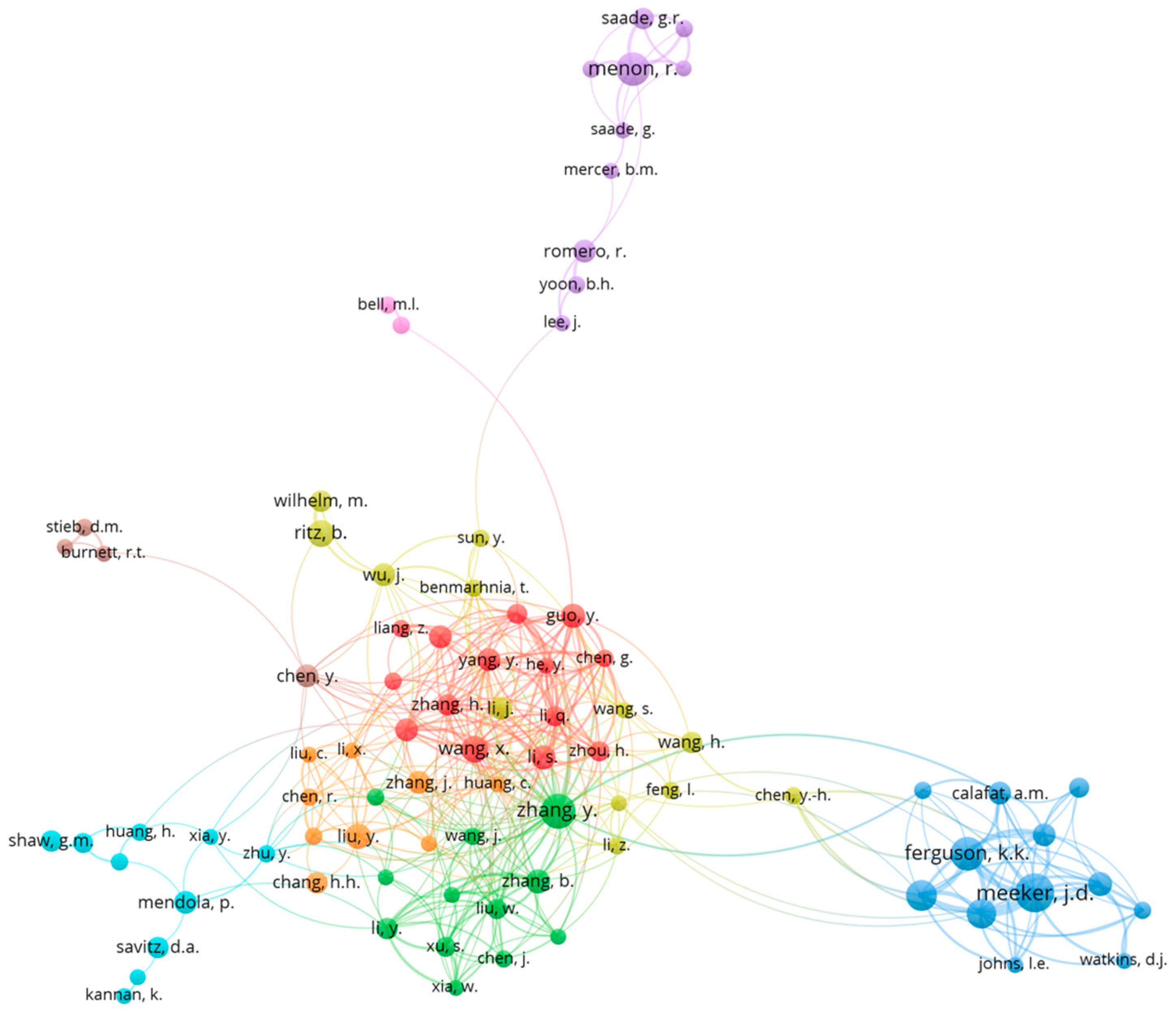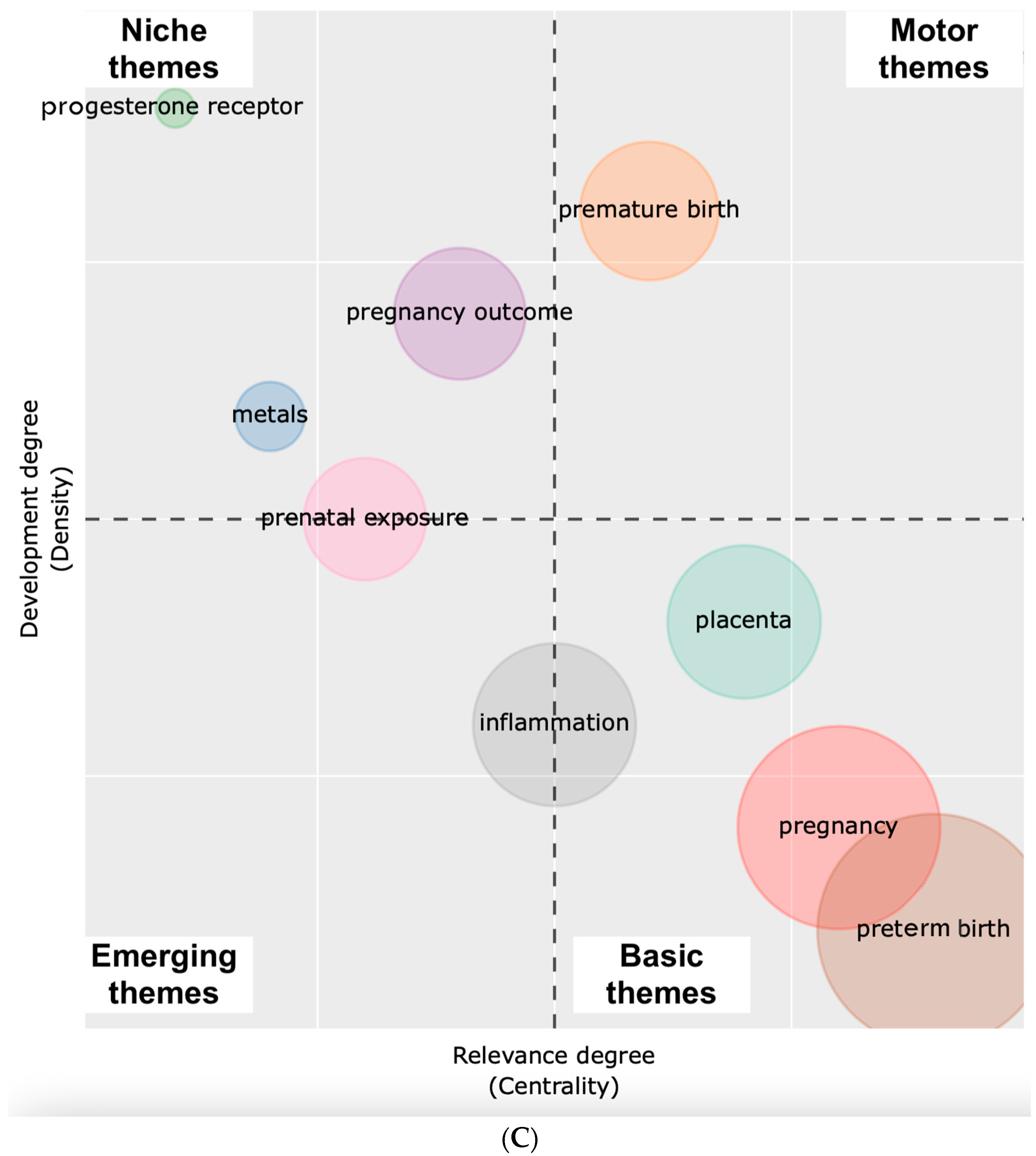Environmental Toxicants and Preterm Birth: A Bibliometric Analysis of Research Trends and Output
Abstract
:1. Introduction
2. Materials and Methods
2.1. Study Selection
2.2. Data Collection
2.3. Statistical Analysis
3. Results
3.1. Publications by Journals
3.2. Publication by Authors
3.3. Publications by Institutions
3.4. Publications by Countries
3.5. Keyword Visualization
4. Discussion
5. Conclusions
Author Contributions
Funding
Institutional Review Board Statement
Informed Consent Statement
Data Availability Statement
Acknowledgments
Conflicts of Interest
References
- OECD. WHO Preterm Birth and Low Birth Weight; OECD: Paris, France, 2020. [Google Scholar] [CrossRef]
- Lamont, R.F. Advances in the Prevention of Infection-Related Preterm Birth. Front. Immunol. 2015, 6, 566. [Google Scholar] [CrossRef] [PubMed] [Green Version]
- Nishimura, F.; Mogami, H.; Moriuchi, K.; Chigusa, Y.; Mandai, M.; Kondoh, E. Mechanisms of Thrombin-Induced Myometrial Contractions: Potential Targets of Progesterone. PLoS ONE 2020, 15, e0231944. [Google Scholar] [CrossRef] [PubMed]
- Waldorf, K.M.A.; Singh, N.; Mohan, A.R.; Young, R.C.; Ngo, L.; Das, A.; Tsai, J.; Bansal, A.; Paolella, L.; Herbert, B.R.; et al. Uterine Overdistention Induces Preterm Labor Mediated by Inflammation: Observations in Pregnant Women and Nonhuman Primates. Am. J. Obstet. Gynecol. 2015, 213, 830.e1–e830.e19. [Google Scholar] [CrossRef] [PubMed] [Green Version]
- Ferguson, K.K.; Chin, H.B. Environmental Chemicals and Preterm Birth: Biological Mechanisms and the State of the Science. Curr. Epidemiol. Rep. 2017, 4, 56–71. [Google Scholar] [CrossRef] [PubMed] [Green Version]
- Bergonzi, R.; Palma, G.D.; Specchia, C.; Dinolfo, M.; Tomasi, C.; Frusca, T.; Apostoli, P. Persistent Organochlorine Compounds in Fetal and Maternal Tissues: Evaluation of Their Potential Influence on Several Indicators of Fetal Growth and Health. Sci. Total. Environ. 2011, 409, 2888–2893. [Google Scholar] [CrossRef] [PubMed] [Green Version]
- Pathak, R.; Ahmed, R.S.; Tripathi, A.K.; Guleria, K.; Sharma, C.S.; Makhijani, S.D.; Banerjee, B.D. Maternal and Cord Blood Levels of Organochlorine Pesticides: Association with Preterm Labor. Clin. Biochem. 2009, 42, 746–749. [Google Scholar] [CrossRef]
- Ritz, B.; Wilhelm, M.; Hoggatt, K.J.; Ghosh, J.K.C. Ambient Air Pollution and Preterm Birth in the Environment and Pregnancy Outcomes Study at the University of California, Los Angeles. Am. J. Epidemiol. 2007, 166, 1045–1052. [Google Scholar] [CrossRef] [Green Version]
- Ritz, B.; Yu, F.; Chapa, G.; Fruin, S. Effect of Air Pollution on Preterm Birth Among Children Born in Southern California Between 1989 and 1993. Epidemiology 2000, 11, 502–511. [Google Scholar] [CrossRef]
- Brauer, M.; Lencar, C.; Tamburic, L.; Koehoorn, M.; Demers, P.; Karr, C. A Cohort Study of Traffic-Related Air Pollution Impacts on Birth Outcomes. Environ. Health Persp. 2008, 116, 680–686. [Google Scholar] [CrossRef] [Green Version]
- Khanam, R.; Kumar, I.; Oladapo-Shittu, O.; Twose, C.; Islam, A.A.; Biswal, S.S.; Raqib, R.; Baqui, A.H. Prenatal Environmental Metal Exposure and Preterm Birth: A Scoping Review. Int. J. Environ. Res. Pu. 2021, 18, 573. [Google Scholar] [CrossRef]
- Visser, L.; de Boer, M.A.; de Groot, C.J.M. Analysis of Publication Interest on Preterm Birth Over Two Decades. Matern. Child Health J. 2019, 23, 1392–1399. [Google Scholar] [CrossRef] [Green Version]
- Institute of Medicine (US); Committee on Understanding Premature Birth and Adverse Health Outcomes. The Role of Environmental Toxicants in Preterm Birth. In Preterm Birth: Causes, Consequences, and Prevention; Behrman, R.E., Butler, A.S., Eds.; National Academies Press: Washington, DC, USA, 2007. [Google Scholar]
- Toom, K. Chapter 10—Indicators. In The European Research Management Handbook—Europe and Beyond; Andersen, J., Toom, K., Poli, S., Miller, P., Eds.; Academic Press: London, UK, 2018; pp. 213–230. ISBN 9780128050590. [Google Scholar]
- Aria, M.; Cuccurullo, C. Bibliometrix: An R-Tool for Comprehensive Science Mapping Analysis. J. Informetr. 2017, 11, 959–975. [Google Scholar] [CrossRef]
- Van Eck, N.J.; Waltman, L. Software Survey: VOSviewer, a Computer Program for Bibliometric Mapping. Scientometrics 2010, 84, 523–538. [Google Scholar] [CrossRef] [Green Version]
- Scopus Database. Available online: https://www.scopus.com/home.uri (accessed on 29 August 2021).
- Web of Science Group. Web of Science Master Journal List. Available online: https://mjl.clarivate.com/ (accessed on 29 August 2021).
- Shah, N.R.; Bracken, M.B. A Systematic Review and Meta-Analysis of Prospective Studies on the Association between Maternal Cigarette Smoking and Preterm Delivery. Am. J. Obstet. Gynecol. 2000, 182, 465–472. [Google Scholar] [CrossRef] [Green Version]
- Ion, R.; Bernal, A.L. Smoking and Preterm Birth. Reprod. Sci. 2014, 22, 918–926. [Google Scholar] [CrossRef] [PubMed]
- Scopus Scopus Preview—Meeker, John D—Author Details. Available online: https://www.scopus.com/authid/detail.uri?origin=resultslist&authorId=7003970613&zone= (accessed on 31 August 2021).
- Scopus Scopus Preview—Ferguson, Kelly K.—Author Details. Available online: https://www.scopus.com/authid/detail.uri?origin=resultslist&authorId=47960986400&zone= (accessed on 31 August 2021).
- Scopus Scopus Preview—Menon, Ramkumar—Author Details. Available online: https://www.scopus.com/authid/detail.uri?origin=resultslist&authorId=35566257700&zone= (accessed on 31 August 2021).
- Liu, W.-Y.; Yu, Z.-B.; Qiu, H.-Y.; Wang, J.-B.; Chen, X.-Y.; Chen, K. Association between Ambient Air Pollutants and Preterm Birth in Ningbo, China: A Time-Series Study. BMC Pediatr. 2018, 18, 305. [Google Scholar] [CrossRef] [PubMed]
- Li, X.; Huang, S.; Jiao, A.; Yang, X.; Yun, J.; Wang, Y.; Xue, X.; Chu, Y.; Liu, F.; Liu, Y.; et al. Association between Ambient Fine Particulate Matter and Preterm Birth or Term Low Birth Weight: An Updated Systematic Review and Meta-Analysis. Environ. Pollut. 2017, 227, 596–605. [Google Scholar] [CrossRef] [PubMed]
- Ali, S.H.; de Oliveira, J.A.P. Pollution and Economic Development: An Empirical Research Review. Environ. Res. Lett. 2018, 13, 123003. [Google Scholar] [CrossRef]
- Zhang, J.; Zhang, Z.; Ballesteros-Pérez, P.; Skitmore, M.; Yang, G.; Philbin, S.P.; Lu, Q. Factors Influencing Environmental Performance: A Bibliometric Review and Future Research Agenda. Int. J. Urban Sci. 2021, pp. 1–27. Available online: https://doi.org/10.1080/12265934.2021.1899845 (accessed on 14 January 2022).
- Sciences, T.N.I. of E.H. Environmental Health Perspectives. Available online: https://www.jstor.org/journal/envihealpers (accessed on 14 January 2022).
- Etzel, R.A. Is the Environment Associated With Preterm Birth? Jama Netw. Open 2020, 3, e202239. [Google Scholar] [CrossRef]
- Moral-Muñoz, J.A.; Herrera-Viedma, E.; Santisteban-Espejo, A.; Cobo, M.J. Software Tools for Conducting Bibliometric Analysis in Science: An up-to-Date Review. El Profesional De La Información 2020, 29, e290103. [Google Scholar] [CrossRef] [Green Version]
- Falagas, M.E.; Pitsouni, E.I.; Malietzis, G.A.; Pappas, G. Comparison of PubMed, Scopus, Web of Science, and Google Scholar: Strengths and Weaknesses. FASEB J. 2007, 22, 338–342. [Google Scholar] [CrossRef] [PubMed]







| Document | Title and DOI | Year | Local Citations | Global Citations | LC/GC Ratio (%) | Normalized Local Citations | Normalized Global Citations |
|---|---|---|---|---|---|---|---|
| Brauer M, 2008, Environ Health Perspect | “A Cohort Study of Traffic-Related Air Pollution Impacts on Birth Outcomes”10.1289/ehp.10952 | 2008 | 71 | 419 | 16.95 | 8.40 | 5.74 |
| Ritz B, 2000, Epidemiology | “Effect of air pollution on preterm birth among children born in Southern California between 1989 and 1993”10.1097/00001648-200009000-00004 | 2000 | 67 | 263 | 25.48 | 3.72 | 1.52 |
| Ritz B, 2007, Am J Epidemiol | “Ambient air pollution and preterm birth in the environment and pregnancy outcomes study at the University of California, Los Angeles”10.1093/aje/kwm181 | 2007 | 60 | 263 | 22.81 | 7.14 | 3.34 |
| Sources | Articles | H-Index | TC |
|---|---|---|---|
| Environmental Research | 53 | 21 | 1289 |
| Environmental Health Perspectives | 47 | 35 | 4662 |
| Environment International | 46 | 20 | 1215 |
| International Journal of Environmental Research and Public Health | 23 | 8 | 186 |
| Science of the Total Environment | 22 | 12 | 413 |
| Environmental Health: A Global Access Science Source | 21 | 14 | 949 |
| American Journal of Epidemiology | 19 | 17 | 1274 |
| Epidemiology | 18 | 16 | 1366 |
| American Journal of Obstetrics And Gynecology | 16 | 13 | 768 |
| Maternal and Child Health Journal | 14 | 8 | 300 |
| Authors | Articles | Articles Fractionalized | H-Index | TC |
|---|---|---|---|---|
| Meeker JD | 27 | 4.07 | 18 | 522 |
| Menon R | 21 | 3.94 | 12 | 560 |
| Ferguson KK | 20 | 3.26 | 16 | 1097 |
| McElrath TF | 17 | 2.94 | 14 | 890 |
| Mukherjee B | 16 | 2.52 | 13 | 733 |
| Ritz B | 13 | 3.39 | 12 | 1664 |
| Cordero JF | 11 | 1.24 | 6 | 272 |
| Calafat AM | 11 | 1.02 | 8 | 502 |
| Mendola P | 10 | 2.49 | 6 | 12 |
| Cantonwine DE | 9 | 1.24 | 9 | 521 |
| Affiliations | Articles |
|---|---|
| University of California | 97 |
| Harvard University | 91 |
| University of Michigan | 67 |
| Emory University | 30 |
| Wayne State University | 25 |
| Yale University | 25 |
| Peking University | 20 |
| National Institute of Environmental Health Sciences | 19 |
| University of South Florida | 19 |
| Sun Yat-Sen University | 18 |
| Country | Articles | TC | SCP | MCP | MCP Ratio |
|---|---|---|---|---|---|
| USA | 343 | 13,798 | 284 | 59 | 0.1720 |
| China | 103 | 1848 | 62 | 41 | 0.3981 |
| Australia | 41 | 923 | 35 | 6 | 0.1463 |
| Canada | 39 | 2497 | 18 | 21 | 0.5385 |
| United Kingdom | 29 | 1181 | 18 | 11 | 0.3793 |
| Korea | 22 | 479 | 15 | 7 | 0.3182 |
| France | 20 | 263 | 17 | 3 | 0.1500 |
| Netherlands | 20 | 1366 | 10 | 10 | 0.5000 |
| Italy | 18 | 445 | 13 | 5 | 0.2778 |
| Japan | 17 | 555 | 12 | 5 | 0.2941 |
Publisher’s Note: MDPI stays neutral with regard to jurisdictional claims in published maps and institutional affiliations. |
© 2022 by the authors. Licensee MDPI, Basel, Switzerland. This article is an open access article distributed under the terms and conditions of the Creative Commons Attribution (CC BY) license (https://creativecommons.org/licenses/by/4.0/).
Share and Cite
Vidal, M.S., Jr.; Menon, R.; Yu, G.F.B.; Amosco, M.D. Environmental Toxicants and Preterm Birth: A Bibliometric Analysis of Research Trends and Output. Int. J. Environ. Res. Public Health 2022, 19, 2493. https://doi.org/10.3390/ijerph19052493
Vidal MS Jr., Menon R, Yu GFB, Amosco MD. Environmental Toxicants and Preterm Birth: A Bibliometric Analysis of Research Trends and Output. International Journal of Environmental Research and Public Health. 2022; 19(5):2493. https://doi.org/10.3390/ijerph19052493
Chicago/Turabian StyleVidal, Manuel S., Jr., Ramkumar Menon, Gracia Fe B. Yu, and Melissa D. Amosco. 2022. "Environmental Toxicants and Preterm Birth: A Bibliometric Analysis of Research Trends and Output" International Journal of Environmental Research and Public Health 19, no. 5: 2493. https://doi.org/10.3390/ijerph19052493
APA StyleVidal, M. S., Jr., Menon, R., Yu, G. F. B., & Amosco, M. D. (2022). Environmental Toxicants and Preterm Birth: A Bibliometric Analysis of Research Trends and Output. International Journal of Environmental Research and Public Health, 19(5), 2493. https://doi.org/10.3390/ijerph19052493







